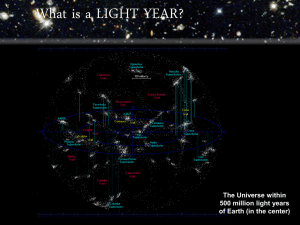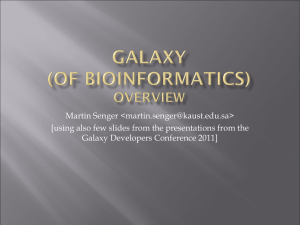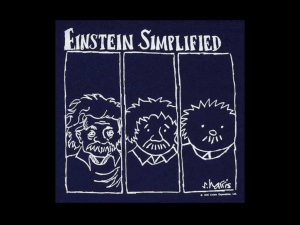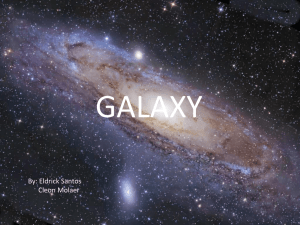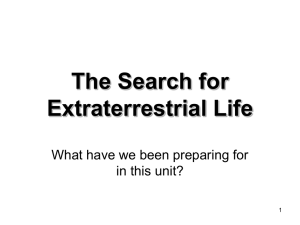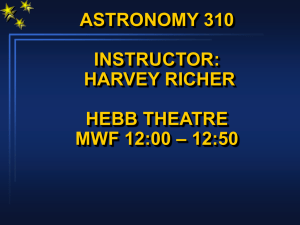1000 Genomes and GATK
advertisement
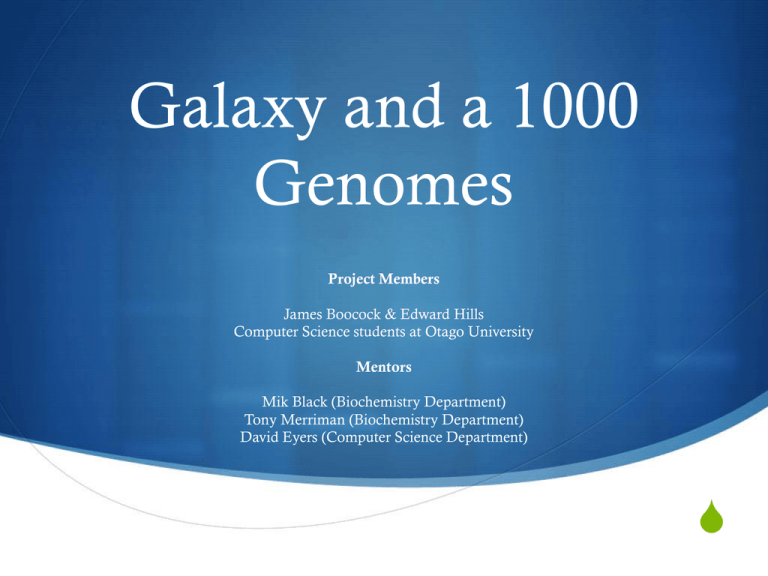
Galaxy and a 1000 Genomes Project Members James Boocock & Edward Hills Computer Science students at Otago University Mentors Mik Black (Biochemistry Department) Tony Merriman (Biochemistry Department) David Eyers (Computer Science Department) S About Us S Edward Hills – Computer Science Honours Student Otago University ehills666@gmail.com S James Boocock – Computer Science graduate Otago University smilefreak2010@gmail.com About the Programme S Summer of eResearch is a New Zealand eResearch initiative which allows computer science and software engineering students throughout the country to work with leaders in eScience fields for 10 weeks. S The project hopes to build relationships between academics and students in computing fields with researchers from other disciplines. S Sina Masoud Ansari - Centre of eResearch Richard Hosking - Programme Coordinator Nick Jones - Director, NZ eScience Infrastructure Our Mentors S Dr. Mik Black – Department of Biochemistry, University of Otago mik.black@otago.ac.nz S Associate Professor Tony Merriman – Department of Biochemisty, University of Otago tony.merriman@otago.ac.nz S Dr. David Eyers – Department of Computer Science, University of Otago dme@cs.otago.ac.nz Introduction S Tony Merriman research group is working on gout within Pacific and Maori populations. S The group is generating raw human sequencing data from a NGS (Next Generation Sequencing) machine. The data is large, novel and slow to produce. S Due to the fact that pacific populations have not been studied in detail previously, the data can and will form the basis for genetic variation for the New Zealand population. GOUT S Is a medical condition characterized by attacks of acute inflammatory arthritis. S Gout affects around 1 – 2 % of the Western population at some point in their lifetimes. S The rates of Gout are higher amoung Pacific and Maori populations. DNA Sequencing S DNA is the molecule containing the genetic instructions using in the development and functioning of all known living organisms. S DNA consists of four bases Adenine, Thymine, Guanine and Cytosine. A, T, C and G respectively. S DNA sequencing is the process of determining the order of bases for a given DNA molecule. S Every functioning cell in the human body contains two copies of your DNA But Why Sequence? S DNA is made up of a heritable unit known as genes. Genes are stretches of the bases (A,T,C and G) that code for proteins which can have a functional role within the organism. S Some diseases are caused by faulty proteins which are encoded by the DNA within the gene. Sequencing the DNA can help determine which base changes are causing the malfunctioning protein. S This understanding can help lead to solutions to the disease. DNA Sequencing S The Biochemistry department at Otago has a sequencing machine known as the Illumina Hi-Seq2000. S The data that is obtained contains the sequence information in a computer readable file format. DNA Sequencing S The data that comes of the Illumina is very, very large and now needs processing. It is simply raw data containing a large list of every base pair that is read. S To process it there are a number of tools that can be used. The Genome Analysis Toolkit made by the Broad Institute is one of these. S Once it goes through this processing pipeline and has been checked against previous sequences, as well as known variants that have been found by the 1000 Genomes Project and other genetic communities, we end up with a Variant Call Format or VCF file. Variant Call Format (VCF) S A Variant Call Format is a file which contains all reads that have been found to differ from the Reference Genome, these are called Single Nucleotide Polymorphisms (SNPs). S A SNP is defined as a read where the base differs from that of the Reference Genome. S The Reference Genome is defined as the ‘most normal’ human and all other sequences are compared against it. S SNPs can cause protein changes which then can cause disease, studying these are important and in our project are our main focus. Motivations for our project S The gap between people who know how to use a computer and those who need to know how is ever growing. S As it stands, many tools that are needed are run on the command-line without a user interface. For people with little knowledge of the command-line this can cripple their work. S The data being produced these days is large and cumbersome and impossible for a human to process manually. Computers have to be used. S Data being produced and analysed needs to be shared with the wider community to save reinventing the wheel. Our Project (finally..) S Our project is to help people that need the ability to create data, analyse data and share their findings with the community in a way that is simple, easy-to-use and familiar to them. S We do this with Galaxy… Galaxy Galaxy S Galaxy is a web interface for large scale computational biomedical analysis. It is widely accepted by the community. S Galaxy is easy to use and has a very small learning curve. S Enabling command line tools to be integrated under the one interface makes it easy and simpler for anyone who is not familiar with the command line but are familiar with the web (which is most people). S Galaxy provides us with the ability to annotate operations performed on datasets, create workflows and share data. Galaxy - Histories S Histories are analyses in Galaxy that show all input, intermediate, and final datasets, as well as every step in the process and the settings used with each. Histories can be imported into your session and rerun as is or modified. Galaxy - Workflows S Workflows specify the steps in a process but not the datasets. Workflows are analyses that are meant to be run, each time with different user-provided datasets. S Workflows can be shared among users and so a particular analysis can be reproduced easily. Galaxy – Tool Creation S Galaxy provides a fairly simple way to create new tools for its web interface. S Because it run anything that can be run via the command line, all that is needed to create a new tool is a XML formatted file with a few special tags that Galaxy needs and then more or less just your command inside the XML. S XML is a tag based markup language for documents, very similar to the way HTML (web pages) are created. Galaxy – Tool Creation Galaxy – Tool Creation 1000 Genomes Project S The 1000 Genomes project is a large effort to sequence all generic variants in the human population. The 1000 Genomes Project or 1KG, provides us with a free public database that is widely accepted as one of the main sources of human genomic data. S The data is unintuitive, cumbersome and hard to navigate. However without it, genomic analysis as we know it would not exist. S The 1KG hopes to sequence 2500 people by the end of the year. They had sequenced over 1000 by the end of 2009. 1000 Genomes Project S For small labs that do not have the resources to conduct a large amount of NGS the 1KG project is a valuable resource as it allows them to access, their raw data as well as previously analysed data. S The 1000 genomes data, if used correctly, can help steer a researcher in the correct direction of a disease causing variant. Integrating Everything! S Our goal is to use Galaxy to provide a much needed interface to things that do not otherwise have them. S Given that Galaxy can run any tool from the command-line, our project’s aim is to get Galaxy and its user friendly interface to use the complicated tools that people are finding difficult and unfriendly but would still like to use. S The 1000 Genomes Project offers us the ability to combine our programs with their data and have it displayed and analysed through Galaxy How we got there S Due to the fact that the area was previously unexplored we started of with little direction or knowledge of the area. This forced us to become somewhat familiar with the biological side of things and also with the range of command line applications that are desired but unusable in the command line form (for all but a few). S The only way to progress was to interact directly with the interested parties. Weekly Meetings S On a weekly or twice-weekly basis we discussed with the end users their needs and wants for our project. S As we were not familiar with the department and the ongoing research, the only way to understand the exact needs was to meet directly. S However the usual client-developer problems arose but were dealt with easily. S Our meetings were rather informal and towards the end of our time, demos of the work we had done were been given there. Weekly Meetings S During meetings formal UML diagrams were created, this helped us know exactly what was needed of us. As the informal discussion was often too unfamiliar for us to follow easily. S The diagrams enabled us to search out tools correctly (or create our own), find the data they want and how they want it and also how the inputs and outputs would be formatted. S After the meeting correspondence would often continue until we had either created the tool they were happy with or we found the task was impossible, too difficult given time constraints or resources were too limited. The Results S TAKE A LOOK! S Upload file S Run Workflow ( containing VEP ) S Explain basics of VEP S What's the point? Summary S Currently as it stands users in the Biochemistry department here at Otago suffer from a lack in computer knowledge or a will to learn computers. S Many tools that they need or want are often only available via the command line and do not have a easy to use friendly GUI. S Galaxy is a means to an end. It provides the ability to operate command-line programs and have a fairly simple to use web interface (seeing as most people are well accustomed to the web). Summary S Many labs are generating sequence data, the datasets are large and not collated. S Our area is mainly human sequence data and our mentors lab is specifically looking and potential variants in Pacific populations. S Galaxy provides a framework to make this link easily accessible and usable. This linking with the public databases for zeroing in on particular variants involved Thanks S We would like to thank eResearch NZ for the opportunity. S Cheers to Nick, Richard and Sina for their help and understanding over the 10 weeks. S Cheers to Tony, Mik and David for their help and direction throughout, it was fun! S Cheers to all the 3rd party vendors whose information and tools we used. Questions?
